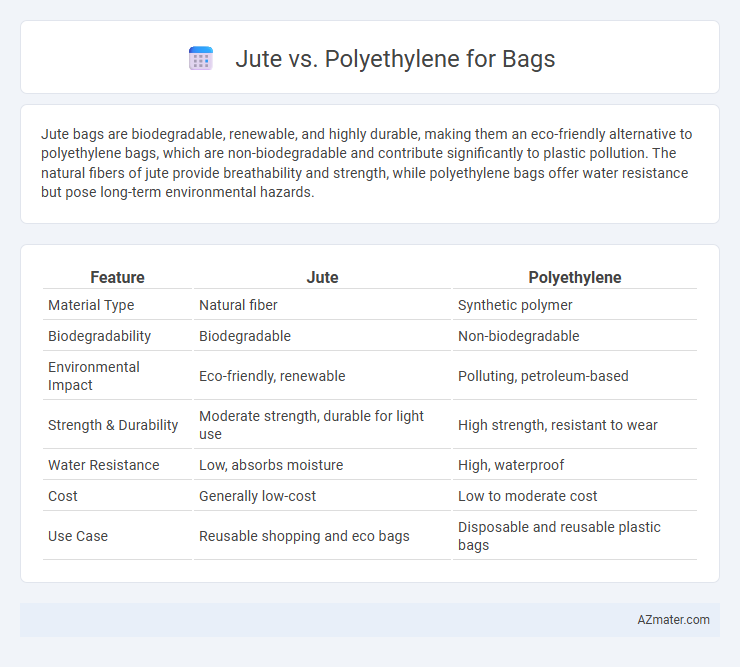Jute bags are biodegradable, renewable, and highly durable, making them an eco-friendly alternative to polyethylene bags, which are non-biodegradable and contribute significantly to plastic pollution. The natural fibers of jute provide breathability and strength, while polyethylene bags offer water resistance but pose long-term environmental hazards.
Table of Comparison
| Feature | Jute | Polyethylene |
|---|---|---|
| Material Type | Natural fiber | Synthetic polymer |
| Biodegradability | Biodegradable | Non-biodegradable |
| Environmental Impact | Eco-friendly, renewable | Polluting, petroleum-based |
| Strength & Durability | Moderate strength, durable for light use | High strength, resistant to wear |
| Water Resistance | Low, absorbs moisture | High, waterproof |
| Cost | Generally low-cost | Low to moderate cost |
| Use Case | Reusable shopping and eco bags | Disposable and reusable plastic bags |
Introduction to Jute and Polyethylene Bags
Jute bags are made from natural fibers derived from the jute plant, offering biodegradability, breathability, and eco-friendliness. Polyethylene bags, produced from synthetic polymers, are lightweight, moisture-resistant, and highly durable, commonly used for packaging and retail purposes. Both materials differ significantly in environmental impact and functional properties, influencing their usage in sustainable packaging solutions.
Material Composition and Production Process
Jute bags are crafted from natural plant fibers derived from the Corchorus plant, featuring a biodegradable, renewable material composition ideal for eco-friendly use. Polyethylene bags are made from synthetic polymers produced through the polymerization of ethylene gas, resulting in a durable, lightweight, and water-resistant product. The production of jute bags involves retting, stripping, and weaving natural fibers, whereas polyethylene bags are manufactured using extrusion and molding techniques in industrial settings.
Environmental Impact Comparison
Jute bags are biodegradable and compostable, significantly reducing plastic pollution compared to polyethylene bags, which are derived from non-renewable fossil fuels and can take hundreds of years to decompose. The cultivation of jute also enhances soil quality and absorbs more carbon dioxide, promoting environmental sustainability, whereas polyethylene production and disposal contribute to greenhouse gas emissions and microplastic contamination. Choosing jute over polyethylene supports lower ecological footprints through renewable resources and minimal toxic waste.
Durability and Strength
Jute bags offer moderate durability and tensile strength, suitable for light to medium usage, but they are prone to wear and degradation under prolonged moisture exposure. Polyethylene bags exhibit superior durability and high tensile strength, resistant to tearing and water damage, making them ideal for heavy-duty and long-term applications. The choice between jute and polyethylene depends on the required lifespan and environmental conditions of the bag's usage.
Cost-Effectiveness Analysis
Jute bags generally offer higher cost-effectiveness due to their biodegradable nature and renewability, reducing long-term environmental costs compared to polyethylene bags. Polyethylene bags, while cheaper upfront, often incur higher disposal and environmental mitigation expenses due to their non-biodegradable properties. The total cost analysis favors jute when factoring in lifecycle costs, sustainability goals, and regulatory compliance for eco-friendly packaging solutions.
Biodegradability and Disposal
Jute bags are highly biodegradable, decomposing naturally within months due to their organic plant-based fibers, making them an eco-friendly choice for sustainable disposal. Polyethylene bags, made from non-biodegradable petroleum-based plastics, can persist in the environment for hundreds of years, posing significant waste management challenges. Biodegradable jute bags contribute to reduced landfill accumulation and lower environmental pollution compared to polyethylene alternatives.
Versatility and Design Options
Jute bags offer exceptional versatility with their natural, breathable fibers, making them ideal for eco-friendly packaging and customizable prints. Polyethylene bags provide superior flexibility and durability, allowing for a wide range of colors, finishes, and design features like resealable zippers. Both materials support diverse branding opportunities, but jute excels in sustainable, rustic aesthetics while polyethylene accommodates more vibrant and intricate designs.
Consumer Preferences and Trends
Consumers increasingly favor jute bags for their eco-friendly and biodegradable qualities, aligning with growing environmental awareness and sustainable lifestyle trends. Polyethylene bags remain popular due to their durability, water resistance, and cost-effectiveness, particularly in regions prioritizing convenience and low price. Market trends indicate a rising demand for jute bags in urban and premium segments, while polyethylene continues to dominate in bulk and high-use applications.
Regulatory and Industry Standards
Jute bags comply with numerous environmental regulations such as the EU's REACH and RoHS directives, emphasizing biodegradability and sustainability, while polyethylene bags face increasing restrictions due to plastic pollution concerns under policies like the EU Single-Use Plastics Directive. Industry standards for jute bags focus on using natural fibers certified by organizations like the Jute Products Development & Export Promotion Council (JPDEPC) and adherence to ISO 9001 quality management systems. Polyethylene bags must meet standards such as ASTM D6400 for compostability when marketed as biodegradable, but often struggle with regulatory scrutiny and bans in markets prioritizing eco-friendly alternatives.
Conclusion: Choosing the Right Bag Material
Jute bags offer superior sustainability with biodegradable fibers and renewable sourcing, making them ideal for eco-conscious consumers seeking natural materials. Polyethylene bags provide enhanced durability, waterproof properties, and lower production costs, suitable for heavy-duty or long-term use. Selecting the right bag material depends on balancing environmental impact, usage requirements, and budget considerations to meet specific needs effectively.

Infographic: Jute vs Polyethylene for Bag
 azmater.com
azmater.com